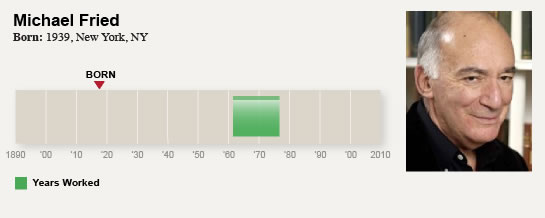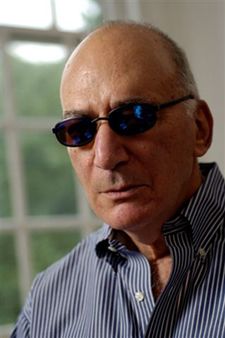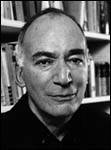
Synopsis Michael Fried is one the most established and reputable art critics and historians alive today. His approach to criticism is closely linked with that of his mentor, the late Clement Greenberg, who Fried first encountered while an undergraduate at Princeton. Much like Greenberg, Fried was suspicious of academics and critics who insisted on critiquing modern art within a historical and/or cultural context, instead of formally examining the work of art on its own terms. Another of Fried's notable contributions was his staunch opposition to what he observed as the lack of differentiation between the work of art itself and the experience of viewing it, a phenomenon he described as "theatricality." Key Ideas / Information
Education and Meeting Clement Greenberg Michael Fried grew up in New York City and at an early age began painting using watercolors and oils. While attending Forest Hills High School, he drew cartoons for the school newspaper. Fried first became interested in art criticism while attending Princeton University as an undergraduate (class of '59). There he met and befriended Frank Stella and Walter Darby Bannard who later became prominent artists in their own right. While poetry and English literature were Fried's intended studies at Princeton, it was the writings of critic Clement Greenberg in Partisan Review and Art News that drew Fried into the world of art and art criticism. Through some correspondence, Greenberg agreed to meet with the young Fried in 1958, and reportedly Greenberg was very impressed with Fried's views on art. According to Fried's account of the meeting some years later, "At one point [he] asked my opinion of Theodore Roszak's sculpture. I said I didn't like it, which impressed him .. He also said that art criticism as usually practiced was a pitiful activity and went on to warn me against the dangers of studying art history." Fried identified this moment as a key stage in his development as an art critic and historian. In late 1958, Fried was awarded a Rhodes Scholarship and began studying at Oxford University. Before departing for England, Fried and Frank Stella socialized with artists Jasper Johns and Robert Rauschenberg in New York. Fried's experiences at Oxford, however, were less than favorable. When he expressed an interest in studying history, he was turned down because he lacked any prior academic training in historical studies. This reasoning puzzled him, and began his occasionally antagonistic relationship with the strict academic constraints of art history. Middle Years  While studying at University College London from 1961-62, Fried began visiting more galleries and writing art criticism pieces with increasing frequency. He also traveled often to Paris and Rome, familiarizing himself with the many galleries and museums available in Europe. It was also during this time that his friend Frank Stella was gaining notoriety in New York City. While studying at University College London from 1961-62, Fried began visiting more galleries and writing art criticism pieces with increasing frequency. He also traveled often to Paris and Rome, familiarizing himself with the many galleries and museums available in Europe. It was also during this time that his friend Frank Stella was gaining notoriety in New York City. By 1961, Clement Greenberg had published Art and Culture to wide acclaim, and some of Frank Stella's works had been shown at The Museum of Modern Art. Through these high-profile acquaintances, Fried was able to establish other connections in the art world that eventually earned him the steady job, at age 22, as the London correspondent for the New York based Arts magazine. In 1962 Fried returned to the U.S. to pursue a Ph.D. in art history at Harvard. By this time he was also writing regular criticism pieces for the journal Arts International. While at Harvard he curated an exhibition at the Fogg Art Museum entitled, "Three American Painters: Kenneth Noland, Jules Olitski, and Frank Stella." In 1967, Fried published an essay entitled "Art and Objecthood," arguably one of the most important pieces of art criticism in the 20th century. Later Career Michael Fried abandoned art criticism in 1977, and steered his writing toward pinpointing the trajectory and overall meaning of Modernism in art, from the 19th century to the present day. He has devoted much of his time to writing long monographs of individual artists such as Édouard Manet and Gustave Courbet. Currently he teaches the Humanities and Art History at Johns Hopkins University in Baltimore, MD. Legacy  Throughout his career, Fried has been far more preoccupied with concepts of Minimalism and Modernism in art than the idea of Abstract Expressionism. He has described the 1960s as the "last great moment in Modernist art." Throughout his career, Fried has been far more preoccupied with concepts of Minimalism and Modernism in art than the idea of Abstract Expressionism. He has described the 1960s as the "last great moment in Modernist art." The critical work of Michael Fried has raised several questions about the role of theatricality, mass culture and kitsch in Modern art, and has questioned whether Modern art has suffered from these phenomena. In justifying his emphasis on formalism, Fried noted that throughout history there have been several specific types of relationships between art and spectator, whereas in the modern era, artists produced works that invited the spectator to actively participate in the viewing experience. Perhaps Fried's greatest contributions to art criticism were his thoughts on the specific effects that art, particularly sculpture, provoked in the viewer. MOST IMPORTANT ESSAYS:
THEORY: Fried on Theatricality, Minimalism and Objecthood In his 1967 essay "Art and Objecthood", Fried posited that Minimalism (what he referred to as "literalism") was compromising the quality of art because such technique was too literal in its meaning, too theatrical, and ultimately an impure practice. In the essay he wrote, "..the literalist espousal of objecthood amounts to nothing other than a plea for a new genre of theatre; and theatre is now the negation of art." Fried objected to the work of Minimalist sculptors like Donald Judd, Sol LeWitt and Dan Flavin, because of their clear love for the fundamental materiality of the work, which resulted in an interactive experience for the viewer. This was, according to Fried, a form of mixed media, in which art and theater commingled to the point where the work ceased to be art, and ultimately was revealed to be merely an object. This "theatricality" in Minimalist sculpture, Fried believed, relegated the work of the literalists to the realm of "anti-art." Such installations, as they eventually became, failed to achieve purity because they failed to properly distinguish between the art and the object. One Minimalist sculptor who was in Fried's favor was Anthony Caro, whose work Fried believed maintained that ever-important differentiation between art and object. According to Fried, Caro's work sustained an internal coherence between art and media. Caro achieved this by painting his sculptures with a flat, non-reflective coat of monochromatic paint, both uniting the discrete parts of the piece and asserting a self-sufficient autonomy from its surroundings. Unlike the literalists, Fried believed, Caro did not draw attention to the objecthood (the materiality) of his works. Fried on Post-Painterly Abstraction If it can be said that Pollock made Greenberg's career and de Kooning made Rosenberg's, then the works of Kenneth Noland, Jules Olitski and Frank Stella made Fried's. The chief aspect of abstract painting was its stark two-dimensionality; in these three artists Fried saw the neutralizing effect of flatness and "a new illusionism [that] both subsumes and dissolves the picture-surface." Fried saw Noland, Olitski and Stella as drawing from the paintings of Pollock, Newman and Louis. These older artists were crucial practitioners in expanding the two-dimensional surface, resulting in the visual illusion of depth. The new generation of post-painterly artists took this one step further: "the development of modernist painting during the past six years [1960-66] can be described as having involved the progressive assumption by literal shape of a greater - that is, more active, more explicit - importance than ever before, and the consequent subordination of depicted shape." In other words, the post-painterly artists used literal shapes on a flat surface in order to bring together canvas, shape and color into one unified whole, where each entity ceased to be independent. Put most simply, these artists achieved a complete flatness by eliminating the illusion of depth Fried on Clement Greenberg No other art critic had a more profound influence of Fried's writing than Clement Greenberg. Fried perceived Greenberg's writing as the equivalent of painting with a broad brush: Greenberg's contribution was to focus on the essentialness of Modern painting in general. Instead of continuing in this vein, Fried used Greenberg's writing as a platform from which to delve into the specific cultural and social effects of Modern painting and sculpture. However broad and formal, Fried established that Greenberg's writing was as crucial to the craft of criticism as the work of Modern artists was to abstract painting. Fried wrote, "One may deplore the fact that critics such as Fry and Greenberg concentrate their attention upon the formal characteristics of the works they discuss; but the painters whose work they most esteem on formal grounds - e.g. Manet, the Impressionists, Seurat, Cézanne, Picasso, Braque, Matisse, Léger, Mondrian, Kandinsky, Miró - are among the finest painters of the past hundred years." There had to be, in Fried's view, the establishment of formal examination of these artists' works before anyone attempted to write a deeper theoretical analysis. Writing Style Fried's writing can be somewhat difficult to read. His approach is very much a Hegelian one: he constantly focuses on the dialectic (oppositional forces) in art, hence his most famous essay, "Art and Objecthood," which attempts to establish the two categorical imperatives of making and viewing art. Despite Fried's tendency to write with overly complex prose, there are constant traces of irony and self-effacement in his essays. He writes in a serious tone without taking himself - or his craft - too seriously. He once wrote that "there is nothing binding in the value judgments of formal criticism. All judgments of value begin and end in experience, or ought to and if someone does not feel that Manet's Dejeuner sur l'herbe..[is a] superb painting, no critical arguments can take the place of feeling it." No matter how much praise a formal critic may bestow upon a certain artwork, if the viewer was not captivated by the experience of viewing it, then that was the only perspective that mattered in that given moment. ARTISTIC INFLUENCES Below are Fried's major influences, and the people and ideas that he influenced in turn. ARTISTS  Édouard Manet  Barnett Newman  Morris Louis  Robert Rauschenberg  Jasper Johns CRITICS/FRIENDS  Charles Baudelaire  Karl Marx  Clement Greenberg  Maurice Merleau-Ponty MOVEMENTS  Impressionism  Post-Impressionism  Expressionism  Action Painting  Abstract Expressionism   Years Worked: 1961 - 1977  ARTISTS  Frank Stella  Kenneth Noland  Jules Olitski  Anthony Caro CRITICS/FRIENDS  Rosalind Krauss  Barbara Rose MOVEMENTS  Post-Painterly Abstraction  Pop Art  Color Field Painting  Combine painting Quotes "The formal critic of modernist painting..is also a moral critic: not because all art is at bottom a criticism of life, but because modernist painting is at least a criticism of itself." "In some ways I was virtually apprenticed to him. I sought him out when I was 19, and was reading him from my teens on. I looked at a lot of art with him. He had a great eye. He's arguably the foremost art critic of the 20th century, and I learned a tremendous amount." (Discussing the influence of Clement Greenberg) "It's the most polemical of all these essays. It champions the art that I admired, but it also comes out against Minimalism at a crucial early moment. Some people absolutely hate it. It's an essay that almost no one agrees with." (Discussing his essay, "Art and Objecthood") "There's very little patience today for the kind of art I was talking about. I feel that most people aren't interested in art at all, in a demanding sense. I don't care whether it's painting or poetry or music or film. The idea of caring whether something is good, for how it works, the kind of involvement that art characteristically demands and rewards, has really gone out. For me that's a loss."  Content written by: Justin Wolf | ||||||
THIS PAGE IS OLD
The Art Story Foundation continues to improve the content on this website. This page was written over 4 years ago, when we didn't have the more stringent/detailed editorial process that we do now. Please stay tuned as we continue to update existing pages (and build new ones). Thank you for your patronage!
IMPORTANT ARTWORKS:
 |  |  |
 |  | |
| FEATURED BOOKS: Written by Fried  Art and Objecthood: Essays and Reviews (in Google Books) Art and Objecthood: Essays and Reviews (in Google Books)  Absorption and Theatricality: Painting and Beholder in the Age of Diderot Absorption and Theatricality: Painting and Beholder in the Age of Diderot  Courbet's Realism Courbet's Realism  Why Photography Matters As Art As Never Before Why Photography Matters As Art As Never Before RESOURCES: Essays by Fried Essays about Fried  Looking back on "the buzz" Looking back on "the buzz" Johns Hopkins Magazine June 1998 Written by Joanne P. Cavanaugh and Dale Keiger  An Evening with Michael Fried An Evening with Michael Fried Arma Virunque, a weblog of The New Criterion January 7, 2006 By Roger Kimball |
 Ask The Art Story AI
Ask The Art Story AI

